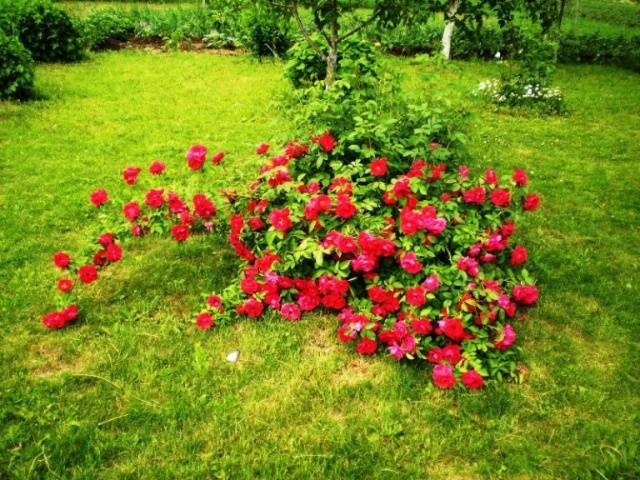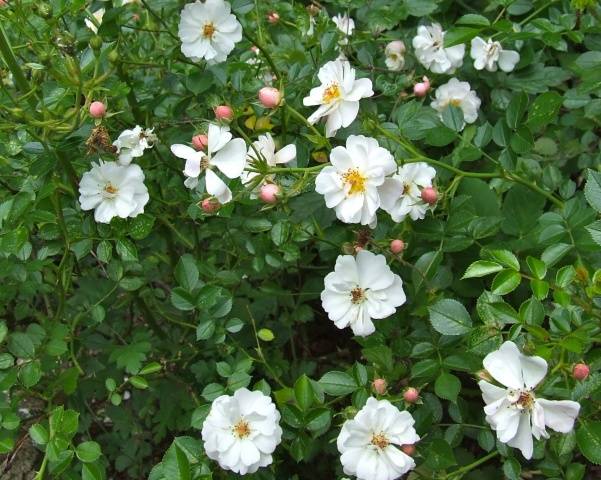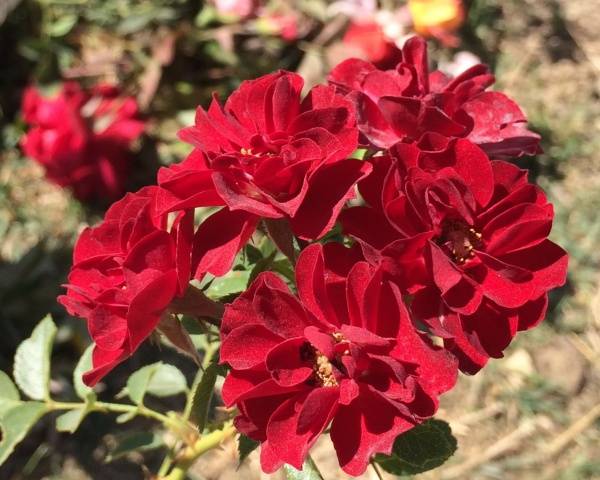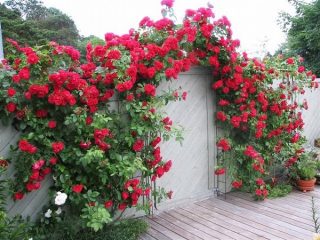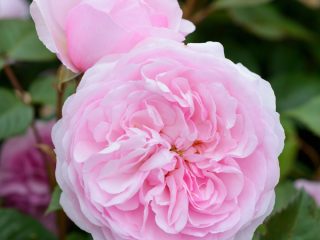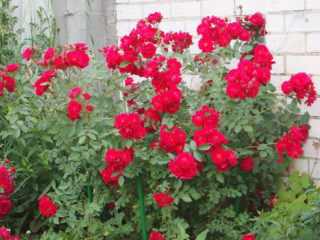Content
The first documentary evidence of cultivated roses came to us from the territory of modern Turkey; they were obtained during excavations of the tombs of the kings of Chaldea in Uru. They said that the Sumerian king Saragon the First brought rose bushes from a military campaign to the city of Uru. Presumably, it was from there that the rose was taken to Greece and the island of Crete, and from there it spread throughout the Western world.
Ground cover roses were isolated from the shrub group only in the mid-80s of the twentieth century. This was due to the fact that in the wake of the increased popularity of ground cover plants, the demand for creeping flowering shrubs also increased. And if in the 70s a few new varieties of these roses were introduced to the market every year, then in the 80s their real boom began.
Description and taxonomy of ground cover roses
Ground cover roses are very diverse. This group includes not only plants with medium-sized flowers and thin creeping shoots, slightly rising above the ground surface, but also widely spread shrubs growing up to 1.5 m in height. The taxonomy of these roses, like other groups, is traditionally confusing.Most often, 4-5 subgroups are distinguished. We bring to your attention the classification given by Dr. David Gerald Hession. In our opinion, it is more understandable than others not only for an inexperienced beginner, but also for an advanced rose grower:
- Miniature creeping flowers, growing up to 30-45 cm in height, no more than 1.5 m in width.
- Large creeping plants, growing more than 45 cm in height and more than 1.5 m in width.
- Miniature drooping flowers up to 1.0 m high, no more than 1.5 m wide.
- Large drooping plants with a height of 1.0 meters or more and a width of more than 1.5 m.
Ground cover roses of the first two subgroups have recumbent shoots, often capable of taking root at the nodes. The varieties of the next two subgroups form wide spreading bushes with long drooping branches.
Some rose growers, for example French ones, generally distinguish only one group. They claim that ground cover roses are only those that grow horizontally, while tall drooping flowers belong to other subgroups. So don’t be surprised if different sources classify one variety as a ground cover, climbing, floribunda roses or shrabam (another unrecognized but very popular variety).
Some taxonomists classify as groundcover low varieties of roses with numerous erect shoots that grow strongly and cover a large area (for example, the varieties “Mainaufeya” and “Snow Belate”).
The first roses of the groundcover group bloomed once per season, had simple or semi-double small flowers and their color was limited to white, pink, and red.Modern varieties are characterized primarily by continuous abundant flowering and a larger palette of colors. Today you can often find varieties with large or dense glasses. All of them are characterized by rapid shoot growth, frost resistance and disease resistance.
History of ground cover roses
The vast majority of varieties have been registered in the last thirty years. This does not mean that ground cover roses did not exist before. The Vihura rose, which can grow 6 m wide, has been grown as a ground cover plant since the nineteenth century, and at the beginning of the last century its varieties and hybrids of a more compact shape and attractive appearance began to appear.
In Japan, there is a creeping variety of Rosa Crinkle, which grows on the dunes and can cover a fairly large area. She is also considered one of the ancestors of modern ground cover varieties of roses.
Repeatedly blooming ground cover roses today firmly occupy one of the leading positions in demand not only among roses, but also among other creeping plants.
Using ground cover roses in design
Ground cover roses very quickly gained popularity; every landscape designer considers it his duty to place at least one even in the smallest area. They are used in flower beds, filling narrow terraces, well-lit spaces between large and small landscape groups. They can act as wide borders.
A flowering plant planted in the middle of the lawn will look great. Roses from the first two groups should be planted on the lawn if it is viewed primarily from above, while tall, drooping varieties will look good from any viewing point.Tall ground cover varieties are quite suitable for growing as a tapeworm.
You can plant any slope with ground cover roses, and this will not only decorate it, but also protect it from erosion. These plants can cover hillocks and other soil irregularities. Using creeping varieties, if necessary, you can disguise the hatch.
Roses of the fourth subgroup are suitable as a low but wide hedge. Because of the spectacular low fence, it is easy to see what is happening outside, and the thorny shoots, which occupy a large area, will protect you from outside intrusion.
Some ground cover varieties are suitable for growing in containers.
Perhaps this video will awaken your own imagination and tell you where to plant this rose in the garden:
Choosing a ground cover rose
Before buying a rose (especially one chosen from a catalog), if you don’t want any unpleasant surprises, carefully read the description and find out more about it from other sources.
People experience the most disappointment when buying ground cover varieties of roses. Usually they appear on the site in spring or autumn, and without buds. Those photographs that we see in catalogs or on pictures attached to bushes sometimes do not reflect the real state of affairs. Varieties of the first and second groups often bloom small-flowered inflorescences, and in the photo of ground cover roses we see a single flower, and even much larger than in reality. As a result, we may be disappointed.
The second point is that by ground cover roses we most often mean a plant with soft creeping shoots, designed to cover a large or small area of soil. But you need to remember that there are also drooping roses that can reach a height of 1.5 m.Probably, the owner who wants to create a bright spot in the corner of the flowerbed, having instead grown a 1.5-meter plant, covering not only the entire flower garden with its shoots, but also part of the path, will receive a shock.
Varieties of ground cover roses
Let's take a closer look at the varieties of ground cover roses.
Avon
Blooming all season low-growing variety with creeping shoots, small leaves and pearlescent flowers with a diameter of about 3.5 cm. Weakly fragrant flowers are collected in tassels of 5-10 pieces, with a weak aroma. At the beginning of flowering they are pale pink in color, but quickly become white, the height of the bush reaches 30-40 cm, and can occupy an area of about 2 square meters. m. In regions with mild winters, it can cover a large area without pruning. Frost resistance and disease resistance are average. Can be grown as a container plant.
Bonika 82
One of the most popular and widespread varieties of the fourth subgroup. The bush can reach a height of 1.5 m, but looks more attractive if it is cut back by half in the spring. The bush is beautiful, spreading, with attractive dark green foliage. It can be grown as a ground cover, container plant or scrub. The first wave of flowering is the most abundant. Flowers with a diameter of 3-5 cm are collected in 5-15 pieces in a brush, when opening they are bright pink, and can fade to almost white. If they are pruned on time, a second and third wave of flowering is possible, otherwise single flowers will form until frost. The variety is moderately resistant to frost, powdery mildew and soaking. Resistance to black spot is weak, especially in rainy summers.
Broadment
This variety continuously blooms with double, yellow, cup-shaped flowers up to 7 cm in diameter.They have a weak aroma and appear singly or collected in clusters of up to 5 pieces. The spreading bush belongs to the third subgroup and its height reaches 60-75 cm. The variety is resistant to diseases and winters well.
Chilterns
A very popular variety, almost every country gives it a different name. It can grow successfully in any climate; according to various sources, it belongs to the third or fourth subgroup. The bush is pressed to the ground, has creeping long shoots with dark foliage. Large, up to 8 cm in diameter, semi-double flowers with a faint aroma are painted in a blood-red color, and it does not fade in the sun. The buds are collected in tassels of 10-30 pieces. The variety blooms continuously throughout the season, is frost-resistant, and is moderately resistant to diseases.
Essex
The variety belongs to the first subgroup and grows well in breadth. Pink simple flowers up to 4 cm in diameter with a faint aroma look great and are collected in tassels of 3-15 pieces. Flowering is repeated, disease resistance is average. The variety has won several awards.
Ferdy
One of the most interesting varieties, however, blooms profusely only once, with coral-pink semi-double flowers up to 4 cm in diameter, collected in brushes of 5-10 pieces, completely devoid of aroma. The bush is dense, branched, with very beautiful leaves, belongs to the third subgroup. It is best not to cut it off at all, just trim the shoots a little in the spring - this way it will show itself in the whole race. It has low frost resistance and high disease resistance.
Flower Carpet
One of the best varieties of the first subgroup. Semi-double or double deep pink cupped flowers with a diameter of up to 6 cm bloom continuously and very abundantly, 10-20 pieces are collected in brushes. Several varieties have been developed that differ from the original only in color.It has high winter hardiness, resistance to disease and getting wet.
Kent
One of the most awarded ground cover roses. Belongs to the third subgroup and forms a beautiful, neat bush that requires almost no pruning. Blooms profusely and continuously throughout the season. Semi-double flowers with a weak aroma have a diameter of up to 4 cm, collected in tassels of 5-10 pieces. Frost resistance is average, disease resistance is high.
Max Graf
This is the oldest variety of ground cover rose that has survived to this day. By its appearance it is easy to determine that it is an interspecific hybrid between Rosehip wrinkled and Rosehip Vikhura. Belongs to the second subgroup. Spiny creeping shoots easily take root on their own and quickly cover a large area. This variety is not suitable for flower beds, but is ideal if you need to cover a slope or quickly cover a large area. Simple fragrant flowers up to 5 cm in diameter are dark pink in color and collected in tassels of 3-5 pieces. The variety blooms once, but has decorative foliage and high resistance to cold and disease.
Pesent
This variety is registered as a ground cover rose, but thanks to its flexible shoots it can be grown as a climbing rose. The lashes raised on a support look even better. Belongs to the second group. It has two waves of flowering, grows strongly, and can quickly cover a large area of up to 7-8 square meters. m. Flowers with a diameter of up to 6 cm are collected in brushes of up to 10-30 pieces, have beautiful wavy petals, are painted coral pink, with a faint aroma. They have high resistance to diseases.
Conclusion
We do not claim to have shown the best varieties of ground cover roses - everyone has their own taste. We only hope that we have piqued your interest and encouraged you to explore these beautiful flowers further.








